

S Strategic Plan for Education. In Ohio, each child is challenged, prepared and empowered.

Each Child, Our Future is Ohio’s shared plan for ensuring that each student is challenged, prepared and empowered for his or her future by way of an excellent prekindergarten through grade 12 (preK-12) education. The plan’s purpose: to lift aspirations, create hope and excitement, guide development of state-level education policies and promote high-quality educational practices across the state. This plan was built by Ohioans for Ohioans. Launched by Ohio’s superintendent of public instruction and the State Board of Education in the summer of 2017, more than 150 Ohio-based partners rolled up their sleeves to develop the plan. With 240,000 educators serving in 3,500 schools and educating more than 1.7 million schoolchildren, education in Ohio is a complex business. View the strategic plan as approved by the State Board Executive Summary Multimedia. Every Student Succeeds Act (ESSA)
The Every Student Succeeds Act (ESSA), which replaced the No Child Left Behind Act, asks Ohio to clearly articulate its plans for using federal funds to ensure accountability for all students, create safe and supportive learning environments, encourage innovation and extended learning opportunities, and more.

What’s happened so far? The state requested and received feedback from thousands of Ohioans since spring 2016 (learn more about stakeholder engagement). Using that feedback, the Ohio Department of Education developed and released an initial draft plan in February 2017. Feedback was received on the initial draft plan and informed the development of a second draft. The second draft was reviewed by the four State Board of Education committees. Following a review by Gov. What’s next? Even as Ohio submits its federal ESSA application this fall, the state is seeking public input to support the development of a comprehensive strategic plan for the education system.
Education International - Latest News on Education. Program for International Student Assessment (PISA) - Overview. Client Services in International Education Standards and Assessment. Institutional Resources. Power Standards: Focusing on the Essential. Power Standards: Focusing on the Essential “If everything is important, then nothing is.” – Patrick Lencioni Each day, teachers are faced with the enormous responsibility of teaching, assessing, and responding to students learning across a high number of dense standards within a limited number of school days.
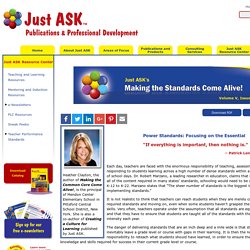
Dr. Robert Marzano, a leading researcher in education, claims that in order to cover all of the content required in many states’ standards, schooling would need to be changed from K-12 to K-22. It is not realistic to think that teachers can reach students when they are merely covering all of the required standards and moving on, even when some students haven’t grasped the content and skills. The danger of delivering standards that are an inch deep and a mile wide is that students will inevitably leave a grade level or course with gaps in their learning.
Reading excerpts how to design learning targets moss brookhart. Learning Targets. Learning Targets “Students should be able to answer three basic questions: Where am I going?
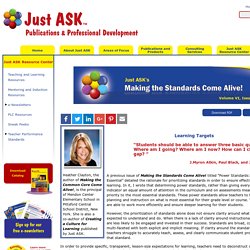
Where am I now? How can I close the gap? ” What teachers should know. Fine Arts Model Curriculum. Fine Arts. View Ohio's Learning Standards in fine arts for dance, drama/theatre, music and visual art.
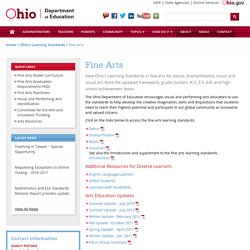
Note the updated framework, grade clusters--K-2, 3-5, 6-8--and high school achievement levels. The Ohio Department of Education encourages visual and performing arts educators to use the standards to help develop the creative imagination, skills and dispositions that students need to reach their highest potential and participate in our global community as innovative and valued citizens.
Art Curriculum. Physical Education Standards. Why We Need to Move Away from SMART Goals and Towards New Forms of Classroom Assessment. Every new school year breathes new life into my professional career.
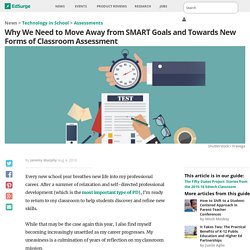
After a summer of relaxation and self-directed professional development (which is the most important type of PD), I’m ready to return to my classroom to help students discover and refine new skills. While that may be the case again this year, I also find myself becoming increasingly unsettled as my career progresses. My uneasiness is a culmination of years of reflection on my classroom mission. My district has taken on new initiatives the past few years (as all districts do) to solve the well-documented, disconnected nature between high school graduates and workplace preparedness. One emphasis has been allowing teachers to communicate with business professionals in the area, discussing the skills they most want to see in potential employees and focusing on the four C’s (critical thinking, collaboration, creativity and communication). “I’m not anti-measurement.
We need to align our purpose. ESSA Summary for Arts Education May 2016. Ohio Arts Assessment Collaborative: Measuring Student Growth in the Arts. High-quality assessments are an integral part of measuring and monitoring student growth and informing classroom instruction.
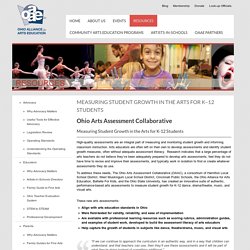
Arts educators are often left on their own to develop assessments and identify student growth measures, often without adequate assessment literacy. Research indicates that a large percentage of arts teachers do not believe they’ve been adequately prepared to develop arts assessments, feel they do not have time to revise and improve their assessments, and typically work in isolation to find or create whatever assessments they do use.
To address these needs, The Ohio Arts Assessment Collaborative (OAAC), a consortium of Hamilton Local School District, West Muskingum Local School District, Cincinnati Public Schools, the Ohio Alliance for Arts Education, Battelle For Kids, and the Ohio State University, has created an innovative suite of authentic, performance-based arts assessments to measure student growth for K-12 dance, drama/theatre, music, and visual arts. 1. EDUCAUSE. Dalia Hochman has been working on educational improvement and innovation for nearly twenty years.
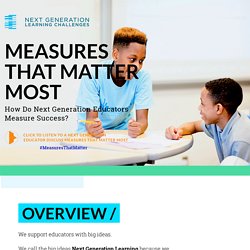
With each new innovation, she has wondered about the ways the education field measures the success of great ideas. A year ago, Dalia began a conversation with Britt Neuhaus at Overdeck Family Foundation. From her experiences supporting innovation as a practitioner at the school and district level, and now as a funder, Britt shared many of Dalia’s questions about what measures matter most as educators test hypotheses for new school designs. MasteryConnect's State Core Apps Make It Easy to Identify Standards. Disclosure: MasteryConnect is an advertiser on this blog.
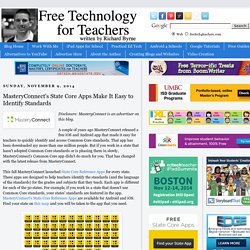
A couple of years ago MasteryConnect released a free iOS and Android app that made it easy for teachers to quickly identify and access Common Core standards. That app has been downloaded my more than one million people. But if you work in a state that hasn't adopted Common Core standards or is phasing them in slowly, MasteryConnect's Common Core app didn't do much for you. That has changed with the latest release from MasteryConnect. Collaboration Rubric. Dok arts.
PARCC Resources & Practice. Common Core Standards. Sample Standards Based Questions. AEP Action Agenda Web version. Visual Art. Professional Learning. Drama/Theater. Cross Disciplinary. Ohio Fine Arts Model Curriculum.